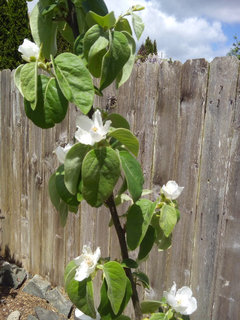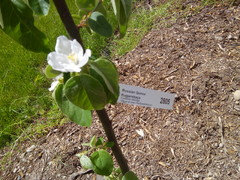Thoughts on breeding new varieties of Quince for eating off the tree
parker25mv
7 years ago
last modified: 7 years ago
Featured Answer
Sort by:Oldest
Comments (7)
pip313
7 years agolast modified: 7 years agoThe Logician LLC
7 years agoRelated Discussions
Plum and pear tree plans for zone 5; quinces?
Comments (12)harvestman, Dave Wilson Nursery grows several million fruit trees a year. You can only buy these through resellers. I got DWN trees from a Naturehills in Nebraska last season. They grew good. The leaves did not drop like all the other trees, they froze off. So I am wondering if the were acclimated to a longer growing season. I ordered late so my local sources were sold out. Last wednesday Scottsmith posted he got Dave Wilson Nursery Trees from Trees of Antiquity. I put a link to that thread below. DWN grows their Warren pear on OHxF333 rootstock. PeacefulValley is also sold out of Warren Pear and so is Trees of Antiquty. Better call Neil.. Here is a link that might be useful: Best fesh prune fruit...See MoreQuince/medlar/shipova grafting?
Comments (15)John of Lamb Abbey, When the bark is not slipping on the hawthorn stock, here is what to do when you want to graft low and the sizes are hugely different. Make a regular whip&tongue cut on your medlar whose caliber is way too small, then carefully make a matching wound in the large rootstock. Then actually make a tongue on the stock by back-cutting, then slide the scion home, matching as well as possible. I frequently use this technique. Maybe I should call it the modified rind/bark-whip&tongue graft! Anyway, it works good and saves the day. Of course, if you can wait till the hawthorn bark is slipping nicely, you can just do a regular bark graft, which work a treat too. Cover the whole scion with grafting glue after completing the graft (prevents the scion from drying out). Make certain that all air holes are plugged so the union cannot dry out. Don't let any glue get into the union either. Dethride, Apple trees are easy to work over from a 12 inch stump from ground level. Unless you want to work each individual branch over, which allows you to put many kinds on one tree. Wait till the tree has put on a leaf or two, then wack it cleanly with a chain saw (if working over individual limbs, a sharp hacksaw makes nice clean cuts!). Score the bark with a sharp knife every 2 inches around the circumference, insert shaved scions into each slit, then bind the whole thing with electrical tape. Plug all holes (combination of small strips of tape and/or modeling clay or plumbers putty), then cover grafted scions with glue. They will all grow over the summer. I have seen them go 6 and 8 feet each! Next winter, save the best upright, cutting all the others back to one or two buds. This keeps the bark alive all around the tree, not letting it die. The huge wound will disappear in 10 years or so, but needs a little maintainance every winter to keep the main upright, the main upright. I coat the ugly wound in the fall (big wound is nice and dry at this point), before rains start with roofing compound, some use copper fungicide. This keeps the wood from rotting before the gap closes. You should be getting apples around 3 or 4 seasons from when you initially graft. I think it is worth it when you don't have to do 1000 trees this way. Great for the homeowner who wants to make use of a wonderful root system already in the ground! For the link below, I recommend the single-cut bark graft. It is less messing around than the double cut kind, and works just as good. Also, the scion (two or three nice buds) need not have any shoulder like they portray. Just a simple long wedge will work fine. And I have never used nails. Some of my scionwood just would not handle a nail as sometimes the scion is too small. Here is a link that might be useful: Bark Graft...See MorePlum tree varieties, Denver
Comments (26)@milehigh- thanks for the story. It's worth a try. I'll have to look up more info then on planting bare root trees together. However, your Japanese American hybrid tree sounds interesting- the best of both worlds... I didn't know Costco sold fruit trees. I may also look into multi-grated trees. @olreader- we did plant fruit trees 2 years ago (I believe). With last year's late frost, not one bloomed. Supposedly, that's ok as we weren't going to let the trees fruit and instead let them funnel that energy to their roots for strength. So, I can't really say how they are doing- except that: Green Gage- died almost instantly North Star cherry- significant growth Honeycrisp- little growth Potomac and Seckle pear trees- little growth New Haven and Elberta peach- significant growth The peach trees are from Dave Wilson, Pears and plum from Cummins and others were local. I'm not sure if the nurseries make a difference but I'm very excited about peaches this year- IF we don't get a late frost. I'm also going to plant in the ground a Chicago Hardy Fig tree this spring! I have an idea of how we might overwinter it- create a leaf insulating barrier with rebar and chicken wire, unless I can find a better way. I don't really care to dig a trench and bury the thing in our clay soil. Oh, this reminds me, I'll probably post a question about netting the trees to keep the squirrels out. And also about kaolin clay on the apple tree to prevent coddling moths from laying their eggs- though I've read that it's too pricey for a non-farmer....See MoreMy fruit tree plans - and quinces in Colorado?
Comments (11)For my part, the apples, pears and plums are all doing well - the apples, except for the Northern Spy, have leafed out, the pears have pushed 3-4" new growth, and the plums are finishing up blossoming. I may well get a good crop of damsons and handful of golden transparents this year. The quince died back to about 6" from the ground - the second year in a row with significant damage - and I'll probably try to find a new home for it in the fall, to be replaced with at North Star cherry. No die back at all on the apples and pears, and only a few inches on a couple of the leggiest verticals of the green gage plum. The fruit tree list at the moment: Apples: Ashmead's Kernel, Calville Blanc, Cortland, Cox's Orange Pippin, Jonagold, Kidds Orange Red, Margil, Northern Spy, Reinette Zabergau Pears: Comice, Magness, Seckel, Warren Plums: Geneva Mirabelle, Golden Transparent, Green Gage, Imperial Epineuse, Shropshire Damson Smyrna Quince All the pears and most of the apples are in an espalier, and the plums are planted 5' apart and pruned as goblets or bushes, depending on their branching angles. Ian...See Morenmfruit
7 years agoParker Turtle
6 years agoyovan mcgregor
6 years agosocalnolympia
5 years agolast modified: 5 years ago
Related Stories

EDIBLE GARDENSWhy Grow Quince? For Beauty, Fragrance and Old-Time Flavor
Delightfully perfumed fruit and lovely spring blossoms make this apple and pear cousin worth a spot in the garden
Full Story
GARDENING GUIDES6 New Plant Varieties That Beat Out Their Parents
With better resistance and fewer demands, these garden beauties are worth a spot on your wish list
Full Story
EDIBLE GARDENSHow to Grow 10 Favorite Fruit Trees at Home
Plant a mini orchard in fall, winter or early spring to enjoy fresh-off-the-tree fruit the following year
Full Story
CURB APPEAL7 Finishing Touches for a Thoughtful Front Yard
Make a great first impression with artful house numbers, water features, garden art and more
Full Story
DECORATING GUIDESOff the Wall: 9 Clever Ways to Ease Into Wallpaper
Not ready for a roomful of wallpaper? Try a little on a door, stairway or chest of drawers
Full Story
SPRING GARDENING7 Spectacular and Practical Spring-Flowering Trees
Put on a beauteous show in the garden with a landscape tree awash in flowers — just do your homework first
Full Story
FALL GARDENING6 Trees You'll Fall For
Don’t put down that spade! Autumn is the perfect time for planting these trees
Full Story
KITCHEN DESIGN16 Scrumptious Eat-In Kitchens and What They Want You to Serve
Whether apple-pie cheerful or champagne sophisticated, these eat-in kitchens offer ideas to salivate over
Full Story
GARDENING GUIDESPrunus Virginiana Thrives Under Deciduous Trees
Plant chokecherry for showy white flowers favored by native bees in spring, and to provide nesting habitat and food for birds
Full Story
EDIBLE GARDENSHow to Grow Your Own Peaches and Nectarines
Make gardening a little sweeter with these juicy fruits, which you can eat after plucking or preserve for later
Full Story






socalnolympia